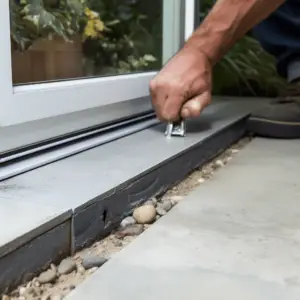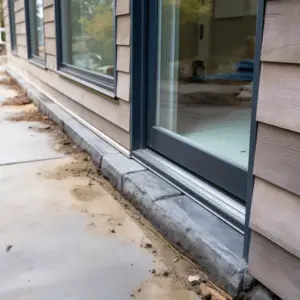Sealing Door Thresholds to Concrete, Thresholds are typical in most homes as they transition between the bedroom and bathroom entries or from door to door. They come in various materials, including marble, stone, metal, and wood. Door thresholds are known as “door saddle” or “door sill.
A proper seal between the threshold and your door results in an efficient home. However, do you know how to seal a door threshold to concrete? To do so, you can install a weatherproof rubber seal or use a liquid seal around an existing entry using specific steps, as we will see in our subsequent sections.
In this guide, we take you through all you require to know about sealing door thresholds to concrete. Read on
Table of Contents
A Step-By-Step Guide on How to Seal Door Threshold to Concrete

The following steps are similar, whether using a liquid seal or installing a weatherproof rubber seal. Therefore, let’s dive into the breakdown of each:
Inspect the Threshold Area
Thoroughly examine the area where you want to apply the seal, measure it and choose the type of material to use.
Watch out for any unevenness or bumps to see if you will require a grinder. In addition, check for openings and cracks to establish any need for repairs before spreading a seal. For the existing threshold, ensure it is in decent condition and not loose.
Select a Suitable Seal for the Threshold
The seal is available in different seal types. The choice depends on your space size and the reason you’re sealing, such as filling around a door threshold with a wooden or metal plate. For tight fits, you can opt for a waterproof sealer and mortar filler that acts as a sealant.
For minor gaps where the visual effect is paramount, use a silicone-based caulk that dries clear. It is ideal for all weather and dries within 30 minutes, and it is simple and available in clear and white.
You can choose minimal expanding foam that suits entryway thresholds for more significant gaps. The regular foam may lead to lifting the point over time, which in turn causes improper doors closing. Some professionals may use both expanding foams together with a silicone seal.
Repair Gaps and Cracks
Do necessary repairs before spreading the sealant. Seal the gaps and cracks with construction putty or liquid cement and let it dry before sanding or grinding the area until it is smooth.
Ensure Proper Fastening of the Existing Threshold
Sealing Door Thresholds to Concrete working on an existing threshold, ensure it fastens well to prevent the seal from weakening within a short span. Change the screws or secure the entry by applying adhesive to the concrete.
How to Secure a Door Threshold to Concrete?
As per the professionals, use Tapcon flathead screws to safeguard a door threshold. Evade using extra-long screws as they’re susceptible to breakage.
Clean the Threshold Area
After repairs, clear any debris, as loose dust makes your seal ineffective and brittle.
Apply a Rubber Seal/ Weatherproof Liquid
After verifying that the area is clean and dry, smear your seal, ensuring the tip of the applicator stays inside the gap, and keep your line straight with the help of the threshold edge.
Allow the Seal or Glue to Dry Effectively
Consider your project and the sealant you’re using. For instance, an entryway sealant requires 30 minutes to an hour to cure, while the rubber seal glue may take 24 – 48 hours to drain entirely.
Why Is The Threshold Important?
As earlier defined, the threshold is the wood, strip, or metal that runs transversely at the bottom of an entry door frame. It is very paramount to the energy efficiency of a building with multiple additional functions in the entrance, such as:
Weather
The core function of the doorway is to offer a seal against heat during summer and cold during winter. Additionally, it safeguards the inners from rainwater that would flow through the entrance.
Act As an Air Barrier
As part of sealing out the incoming cold and hot airflow, the threshold is a barrier to prevent the interior air from leaking. As a result, you reduce heating and cooling costs as you evade the need to frequently replenish the cold and hot air that could seep out beneath the door without a threshold.
Pests and Insect Barrier
Thresholds also aid in keeping away unwanted insects and other small creepy insects that can fit beneath a door. These include Cockroaches, mice, etc. You can match the threshold alongside a door seal to form a robust barrier.
Prevent Unwanted Light and Noise
Noise and light can be proper destruction preventing you from getting good rest and privacy in your home. Therefore, thresholds help to avert such.
Act as a Decorative Addition to a Room
Regardless of thresholds merging well with the floor, some can add a decorative element factor to the floor because of their conspicuous colors. It helps in leveling bumps on the floor/floor that are not uniform. Enables the door to open and close seamlessly
How to Choose the Right Door Threshold

There are quite some factors you should put into consideration, such as:
Location- The amount of traffic and water it has to endure relates to its location
Material-Thresholds are available in various materials. However, an aluminum door threshold has more extended longevity than those made of wood. They’re also easier to maintain, thus looking attractive.
On the hand, wood offers a warmer, more natural feel to a room. You can paint wood to blend with the room décor. However, they easily warp from long water exposure with a need for regular replacement of your door threshold.
Height- Door thresholds come in various sizes. Too low ones will not fill beneath door space, while too high will interfere with the smooth door opening and closing.
Is a Door Threshold Necessary?
There are multiple functions of the threshold. You might overlook them, but they’re paramount if targeting weatherizing your home and helping you accomplish comfort and energy efficiency at its best. Examine the areas that need door threshold to be installed or replaced and use the procedure above to seal the door threshold and enjoy the comfort of an energy-efficient home.
